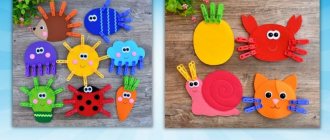Development of fine motor skills in children 4-5 years old
The same exercise can be performed by turning one hand with the back of the palm facing up.
You can perform leg exercises while sitting on a chair.
"Be healthy"
Place the ball on the floor. Place one foot on top of the ball. The other leg is firmly on the floor. Sit up straight, press your back against the back of the chair. Roll the ball back and forth with your foot, slowly. Then, the same movement is performed with the other leg. This exercise can be performed with both legs, rolling the ball alternately, or with both legs at the same time. Alternatively, you can make circular movements with one leg, then the other. The exercise is performed at a slow pace with a good range of motion. The exercise can be performed with both legs at once, either alternately, or with both legs at the same time.
"Slide"
Take off your shoes. Sit on a chair. One leg stands firmly on the floor, and the other is straight forward, toes extended. Take the ball in the hand opposite to your outstretched leg. With this hand, begin to lift the ball up your leg. Cover the ball with your hand and hold it for a count of 5, then “lower” it down the slide. Repeat the same exercise with the other leg. Then increase the count to 10. The exercise is performed slowly, with a good range of motion. Exercises for children 6-7 years old
"Soldiers"
Press both hands tightly towards you with your elbows. Take the ball in one hand. Perform circular movements first with one hand, then transfer the ball to the other hand and perform the same exercise. Perform movements slowly, without rushing. Circular movements are performed towards and away from yourself. When the child learns how to perform the exercise correctly, the tempo can be increased. Make sure that the child does not raise his shoulder. When the child learns how to perform the exercise correctly with one hand, you can ask him to perform the same exercise with both hands at the same time.
"Training"
Place both hands on your elbows and press them tightly to you. Take the ball in one hand. Perform back and forth movements with your hand, then transfer the ball to the other hand and perform the same exercise. Perform movements slowly, without rushing. When the child learns how to perform the exercise correctly, the tempo can be increased. Make sure that the child does not raise his shoulder. When the child learns how to perform the exercise correctly with one hand, you can ask him to perform the same exercise with both hands alternately or simultaneously. When performing some exercises, you can place your hands on the table. The height of the table should be such that the child sits straight at the table without hunching over.
Hand massage
Finger massage is very useful for a small child. For the development of speech, attention and fine motor skills. Thanks to finger games, creativity and reaction speed develop, children better learn concepts such as “above”, “below”, “left”, “right”, learn to count, and simply improve their mood. Thanks to this massage, the “manual intelligence” located on the tips of the fingers and palms is activated. Regular repetition of exercises has a beneficial effect on speech, increases mobility and flexibility of the hands, which helps to successfully master writing skills.
Peculiarities
In preschool age, motor skills normally become more diverse and complex compared to 2-3 years of age. The proportion of manipulations requiring coordinated hand actions is increasing. You need to know what age-related characteristics characterize the development of fine motor skills in children 4-5 years old in order to direct it in the right direction.
- By the age of 3, children’s finger movements become at least somewhat similar to the movements of an adult.
- Fine motor skills previously acquired are improved.
- Children learn to put things in a certain place.
- Until the age of 3, the baby grasped and held mainly with his palm, but now he uses his fingers more actively.
- Preschoolers from 3 to 5 years old try to draw circles and lines, cut paper with scissors, take off and put on loose, loose clothes.
- Fine motor skills are now being developed in conjunction with the kinesthetic sense. The child begins to become aware of the position and movement of his own body in space. The process of development of visual-tactile-kinesthetic connections starts. Thanks to this, hand movements are performed under visual control.
Thus, the development of fine motor skills of the hands in children 3-4 years old occurs sequentially, gradually. First you need to learn how to reach out to grab an object, and then manipulate it. Coordination of the movements of both hands and eyes is important in this process. Teachers, psychologists, and physiologists have determined the norms and deviations in the development of fine motor skills in preschool age.
Deviations
If the development of fine motor skills in children 3-4 years old is insufficient for this age, the child will experience characteristic deviations from the norm:
- movement technique is impaired;
- motor qualities suffer: agility, speed, strength, coordination, accuracy;
- psychomotor deficiencies are diagnosed;
- poorly formed basic self-service skills;
- poor technical skills in drawing, modeling, design, appliqué;
- inability to hold a brush or pencil correctly and regulate the pressure on them;
- difficulty using scissors.
If the development of motor skills in children 4-5 years old occurs according to this plan (5-6 violations), these are deviations. Despite the absence of gross motor disorders, the level of physical and motor progress is much lower than that of normally developing preschool children. And here it is very important to recognize this in time.
How can you help your child?
- we remember and draw “classics” on the asphalt.
- We offer different ways of moving, for example: backwards like a crab or sideways like a sea crab, like a clubfooted bear, moving like a “wheelbarrow” on your hands (an adult holds the child’s legs suspended), etc.;
- create games on unstable surfaces (suggest, for example, to climb over large pillows, look for treasure, or even let your child jump on the bed J);
- don’t forget about all kinds of ball games (with big ones, airy ones, small ones).
- arrange obstacle courses (arrange several objects so that the child needs to go around them, jump over them, crawl under them, climb over them) this allows you to combine the use of a variety of motor skills in one game;
- Games on children's playgrounds, with swinging bridges, nets, ropes, various stairs, descents and ascents are great;
- Swimming will also be useful.
How fine motor skills develop
The motor skills of a five-year-old and an infant are significantly different. Babies are just learning to control their hands, having only a grasping reflex in their arsenal. Later it transforms into a purposeful gesture that will allow the child to reach his favorite rattle, and then get to his feet.
During infancy, fine motor skills develop through tactile perception. The baby enjoys running his fingers over objects with different textures and learns to recognize information that is transmitted through sensations. At this time, a powerful foundation is laid for further development and a fulfilling life, because the ability to feel the texture of an object with our fingertips allows us to navigate in the dark, play musical instruments, etc.
- By the end of the first year of life, the baby firmly holds small objects, knocks toys on a hard surface, and knows how to lay out and assemble a pyramid.
- From 2 to 3 years old, palm movements actively develop, and grasping of an object with the index and thumb appears.
- At 3-4 years old, the baby’s hand movements are coordinated and aimed at solving a specific problem. He can spend a long time drawing, sculpting, buttoning and unbuttoning clothes.
- From the age of 5, a child can easily handle a zipper, tie shoelaces, can independently untie a knot, work with scissors, and draw straight lines and geometric shapes.
Diagnostics
To identify that the development of fine motor skills in children 3 years of age and older is impaired, diagnostics is needed. A specialist will tell you the exact results, but it can also be done at home. Ask your child to do the following simple exercises.
- Read him a nursery rhyme while performing simple movements with your fingers and hands, and then ask him to repeat them after you.
- Extend your arms in front of you. One hand is clenched into a fist, the other is straightened. You need to slowly but simultaneously change the position of your hands.
- He should be able to “walk” along a flat surface with his fingers (index and middle fingers alternately).
- He should be able to “bend his fingers” one by one, starting with the little finger.
- Ask him to do the pinch-palm exercise. It is proposed to join the fingers of the left hand in a pinch as if it were depicting the beak of a woodpecker, and tap on the right palm, which should be vertically open. Do the same, changing hands.
- Ask to unfold both hands at the same time in a strict sequence: fist - edge of the hand - palm.
- In front of the child, disassemble the pyramid and give him the task of putting it back together.
- A similar exercise with a nesting doll: first they take it apart in front of him, and then ask him to put it back together.
- Ask to draw a house consisting of ordinary elements that are easy to reproduce even without the talent of an artist. Check how accurate the copy you receive is. Pay special attention to such small elements as a porch, a pipe, a door - they will indicate the dynamics of development in the hands of fine motor skills.
- Offer to trace the drawing point by point, but discuss in advance that you cannot tear the pencil (pen, felt-tip pen) from the paper.
- You need to shade the figure with straight lines, while trying not to go beyond its contours. Ask your child to use different types of shading: horizontal, vertical, diagonal, wavy.
Now take stock. If at 3 years old he is allowed to perform at least 30% of all these exercises, then by 5 years old fine motor skills should be so developed that 80-90% of these tasks are considered the norm. If your indicators are lower, you need to work more with your baby. Otherwise, this will then have a disastrous effect on his further speech and even intellectual development.
The most important factor that determines the development of fine motor skills in children 3 years of age and older is timely organized assistance of a correctional and pedagogical nature. Children with disabilities should be sent to correctional groups at specialized kindergartens. To prevent this from happening, parents should work with their preschool child as much as possible, developing fine motor skills in the fingers: there are a lot of techniques and methods.
Why do you need to develop fine motor skills?
The human brain is designed in such a way that in the motor area the speech zones and the projections of the hands are located nearby. Hence the relationship can be traced: the faster the movements of the hand and fingers develop, the better the child’s speech becomes. We can say that motor skills play a decisive role in the process of mastering the functions of the speech apparatus.
Group classes for the development of fine motor skills contribute to the socialization of the child. They are conducted in a playful, exciting and educational way. During such training, children learn behavioral patterns, social norms and psychological attitudes. They gain invaluable skills to perceive and process information, which will later enable them to do well in school.
Calligraphy, which is simply impossible without the active development of fine motor skills, will also improve academic performance. A child with a developed hand holds a pen more confidently and will be able to enter all the necessary strokes to write letters.
The development of fine motor skills has a positive effect not only on speech, but also on imagination, cognitive function, observation, memory (visual and auditory). That is, we can talk about the comprehensive development of the child using methods of influencing the motor functions of the hand.
When should you start developing fine motor skills?
From birth. During the first month of life, the baby's hands are almost constantly clenched into fists due to hypertonicity. Over the next 2-3 months, the palm gradually straightens. To speed up this process and relieve stress, you should massage your arms, paying special attention to your palms. However, do not overdo it with unclenching your fist - this should be done easily, without effort, and only if the baby does not mind.
Rub your palm, hand, bend your fingers one at a time, massage your joints, shake your pen in the air. Repeat the massage daily at the same time, preferably in the morning.
When your baby learns to grasp rattles or hold your finger, lightly tug on it (or the toy), as if taking it away. Let him learn to control his hand and train his grip strength. Over time, when the hypertonicity completely goes away, you can start playing games with jokes: “Ladushki”, “Magpie-Crow”, “Horned Goat”, etc. Children not only really like them, but also develop fine motor skills - the first purposeful movements of the brush and fingers.
And then everything depends on the parents’ imagination, motivation and availability of free time.





